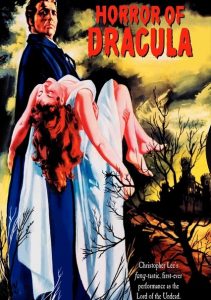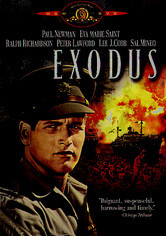Horror of Dracula-1958
Director Terence Fisher
Starring Peter Cushing, Christopher Lee
Scott’s Review #1,083
Reviewed November 17, 2020
Grade: B+
The first colorized retelling of the classic vampire film starring Bela Lugosi from 1931, Horror of Dracula (1958) infuses style and a modern feel into the production making it a formidable entry compared to the original.
The film launched the popular and delightful British Hammer Horror film series, which included eight Dracula sequels.
British horror films nearly always add macabre elements and a British sophistication that merges class with gothic. For maximum effect, they are perfect late-night watches during the Halloween season.
The atmospheric tone is key and will delight horror fans. The addition of horror stalwarts Peter Cushing and Christopher Lee enhances the pleasures.
On a gloomy night in 1885, a librarian named Jonathan Harker (John Van Eyssen) arrives at Count Dracula’s castle in Romania to begin his new assignment.
Secretly a vampire hunter, he is bitten by a desperate woman, really a vampire, begging for help. Jonathan manages to kill the woman but is then killed by Dracula (Lee). Doctor Van Helsing (Cushing) arrives at the castle to investigate, but Dracula already has designs on Jonathan’s fiancée, Lucy (Carol Marsh).
A battle of good versus evil ensues.
Lee brings sexuality to Dracula, which Lugosi lacks, though Lugosi is the creepier of the two. I love the close-up scenes where Dracula bears his enormous fangs and his eyes turn red in a good close-up style.
The casting of Lee is perfect as he becomes identifiable even in the first installment. I also love how Lee is tall, giving the character a menacing, foreboding, distinguished look.
Many might secretly welcome him nibbling on their necks!
Cushing, later to be cast as the villain, is terrific as the empathetic Van Helsing. Lee and Cushing play well against each other. Van Helsing is stoic and confident as he smoothly leads the charge against Dracula and guides Jonathan’s loved ones into unchartered and unimaginable territory. It’s almost as if he has been through this before.
A great scene occurs when Van Helsing arrives in town for a brandy and a drink at the local pub. Its inhabitants are suspicious and frightened, draping garlic over the entryway and hoping he will leave soon.
The best part of House of Dracula is the atmosphere we are treated to, and the color razzles dazzle. The story is good, but the texture powerfully shines through.
Careful not to be too showy, director Terence Fisher, soon to be a Hammer horror prominent fixture, uses his limited budget to his advantage in clever form.
Fisher realized his project was a colorized version and created a polished-looking, colorful stained glass window, which is prevalent in several scenes. Dracula’s castle, especially the bedroom where Jonathan stayed, is part cozy and homespun, part gothic and chilling. The cellar crypt is equally vast yet confining, as the open coffins reveal who lies in them.
The plethora of books elicits a cerebral feeling.
The finale is well done but not as spectacular as expected. Other parts are better. Van Helsing chases Dracula in a race against the sunrise, ripping curtains down to provide harsh light and turning Dracula to dust.
I was expecting a little more and more blood or a good stake through the heart. Fortunately, that entertainment was provided earlier in the film.
Having never read the 1897 Gothic horror novel by Bram Stroker (it’s on my list!), the film is pretty on target.
The film bestows creepy elements and sexuality with great color, lighting, and set design. The lesson learned is that a hefty budget and CGI can’t replicate the creative design and sound effects.

